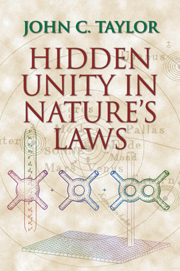Book contents
- Frontmatter
- Contents
- Preface
- 1 Motion on Earth and in the Heavens
- 2 Energy, Heat and Chance
- 3 Electricity and Magnetism
- 4 Light
- 5 Space and Time
- 6 Least Action
- 7 Gravitation and Curved Spacetime
- 8 The Quantum Revolution
- 9 Quantum Theory with Special Relativity
- 10 Order Breaks Symmetry
- 11 Quarks and What Holds Them Together
- 12 Unifying Weak Forces with QED
- 13 Gravitation Plus Quantum Theory – Stars and Black Holes
- 14 Particles, Symmetries and the Universe
- 15 Queries
- APPENDIX A The Inverse-Square Law
- APPENDIX B Vectors and Complex Numbers
- APPENDIX C Brownian Motion
- APPENDIX D Units
- Glossary
- Bibliography
- Index
2 - Energy, Heat and Chance
Published online by Cambridge University Press: 20 January 2010
- Frontmatter
- Contents
- Preface
- 1 Motion on Earth and in the Heavens
- 2 Energy, Heat and Chance
- 3 Electricity and Magnetism
- 4 Light
- 5 Space and Time
- 6 Least Action
- 7 Gravitation and Curved Spacetime
- 8 The Quantum Revolution
- 9 Quantum Theory with Special Relativity
- 10 Order Breaks Symmetry
- 11 Quarks and What Holds Them Together
- 12 Unifying Weak Forces with QED
- 13 Gravitation Plus Quantum Theory – Stars and Black Holes
- 14 Particles, Symmetries and the Universe
- 15 Queries
- APPENDIX A The Inverse-Square Law
- APPENDIX B Vectors and Complex Numbers
- APPENDIX C Brownian Motion
- APPENDIX D Units
- Glossary
- Bibliography
- Index
Summary
How heat is explained as random motion.
Introduction
Heat is just random motion; more accurately, heat is any random process that involves energy. This short sentence needs a lot of explanation to make sense of it. It certainly requires a definition of energy. More difficult, and even controversial, is the word random.
The general idea that heat is a form of motion goes back at least to Galileo. It was a widespread notion in the seventeenth century, favoured by, for example, Robert Boyle (1627–1691). It fitted in with the Newtonian world view, and Newton himself believed (roughly correctly) that heat caused substances to expand because their atoms vibrated more.
There was an opposing theory that heat was a sort of “subtle fluid”, often called caloric (the word was coined by the great French chemist Antoine-Laurent Lavoisier). This went along with the idea that there were also electric and magnetic “fluids”. The caloric theory also suggested that, if the fluid could not be created or destroyed, then there should be, in some sense, “conservation of heat”. This idea opened the way to a quantitative theory, with heat being something that could be measured. It was not obvious how to make the motion theory of heat quantitative in the same way, and throughout the eighteenth century the caloric theory seemed to many people to be more fruitful.
Not until the second half of the nineteenth century was the motion theory of heat fully understood and established.
- Type
- Chapter
- Information
- Hidden Unity in Nature's Laws , pp. 32 - 69Publisher: Cambridge University PressPrint publication year: 2001



